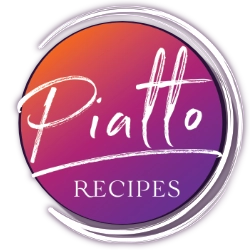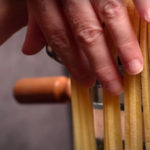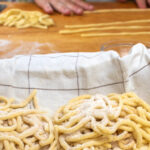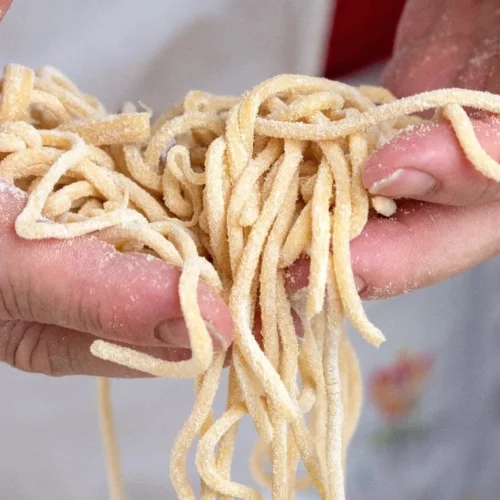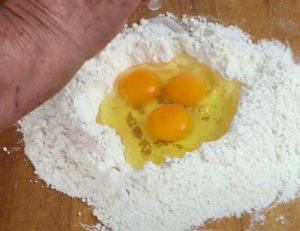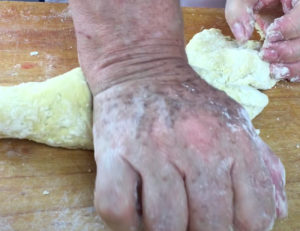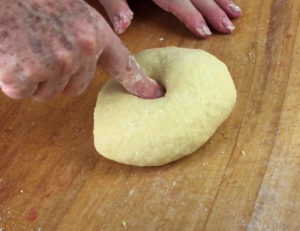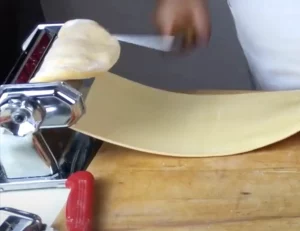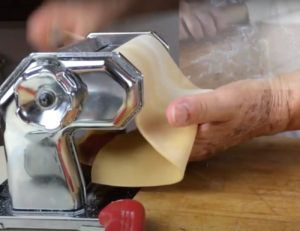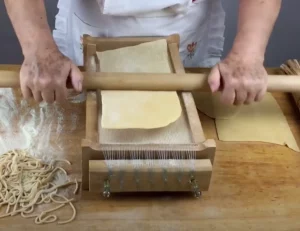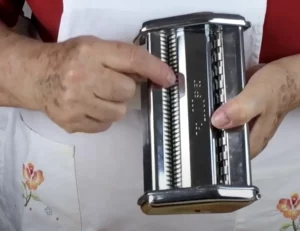Spaghetti alla Chitarra is a special kind of fresh spaghetti beloved in Italy for its taste and texture! It’s a traditional pasta of the Abruzzo region of Italy (east of Rome) that is cut into a 2mm square diameter using a special ‘guitar’ (chitarra in Italian) pasta cutter.
In fact, it is this kind of spaghetti which accompanies the only traditional Italian pasta combining spaghetti with meatballs: the tiny meatballs famous in the Abruzzo dish. Keep reading or jump to our recipe below to learn how to make fresh Spaghetti alla Chitarra with Nonna Lulu!
Watch the Video Recipe!
Watch Nonna Lulu make fresh spaghetti and cut it with her chitarra:
Subscribe to our YouTube Channel
More video recipes? Subscribe to our YouTube Channel (it’s FREE) and click the bell to get notifications when we release a new video recipe!
Where to Find a Chitarra Pasta Cutter?
Aside from the novelty, why bother to buy and use a ‘chitarra’ to cut fresh spaghetti pasta? As Italians well know, the tool used to cut pasta contributes a lot to the texture (and thus taste) of the final pasta. Pasta cut by hand, with a bronze dye or with a ‘chitarra’ adds more texture to the pasta. More texture means that the pasta tastes better, but also that the sauce can cling better to the pasta. For all of these reasons, the taste and texture of Spaghetti alla Chitarra is prized.
Nonna Lulu has had her ‘chitarra’ for decades. Fortunately you can also find fine ‘Made in Italy’ chitarras on Amazon (affiliate link): https://amzn.to/41KdIvh
'Made in Italy' Chitarra on Amazon! Chitarra Pasta Cutter: https://amzn.to/41KdIvh
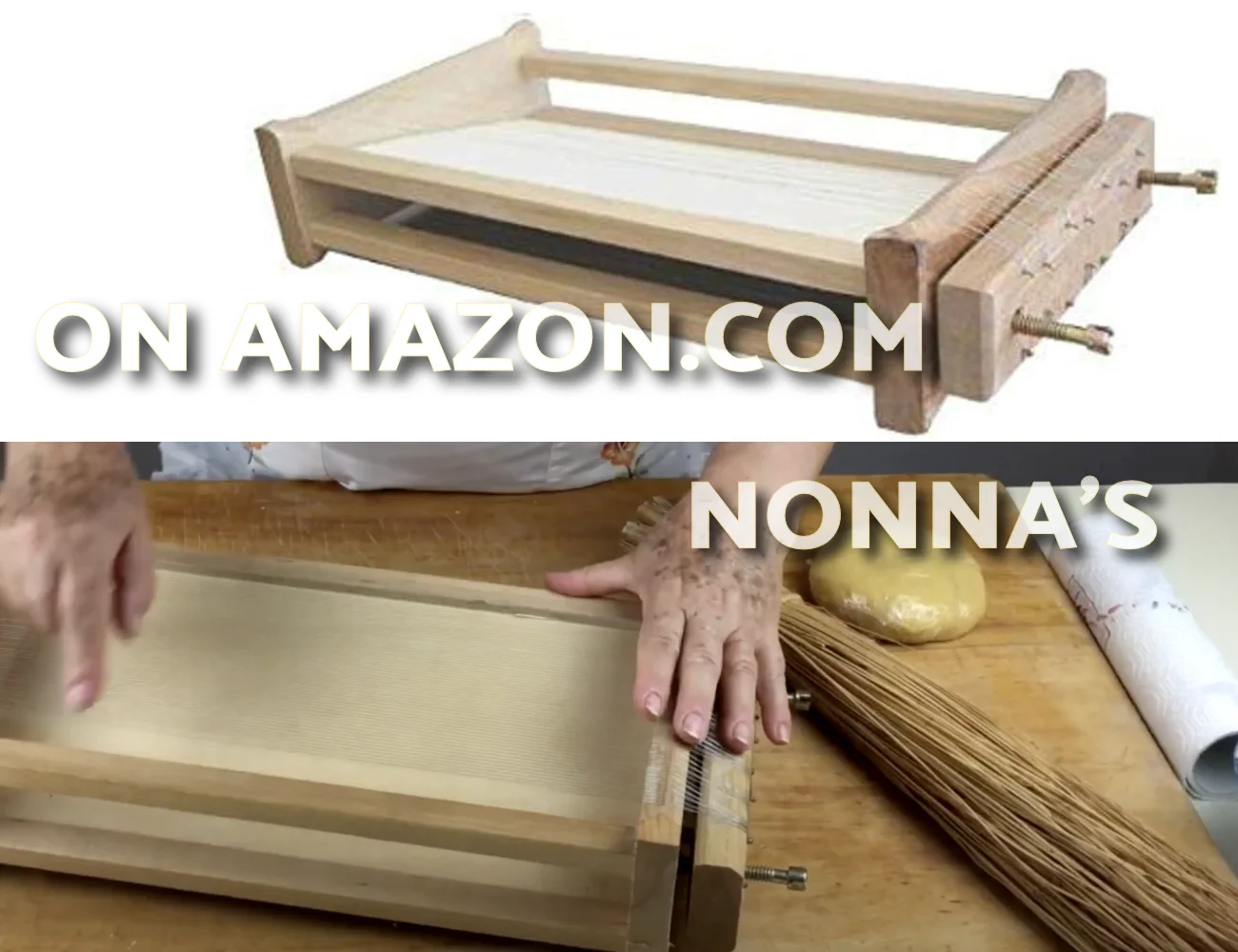
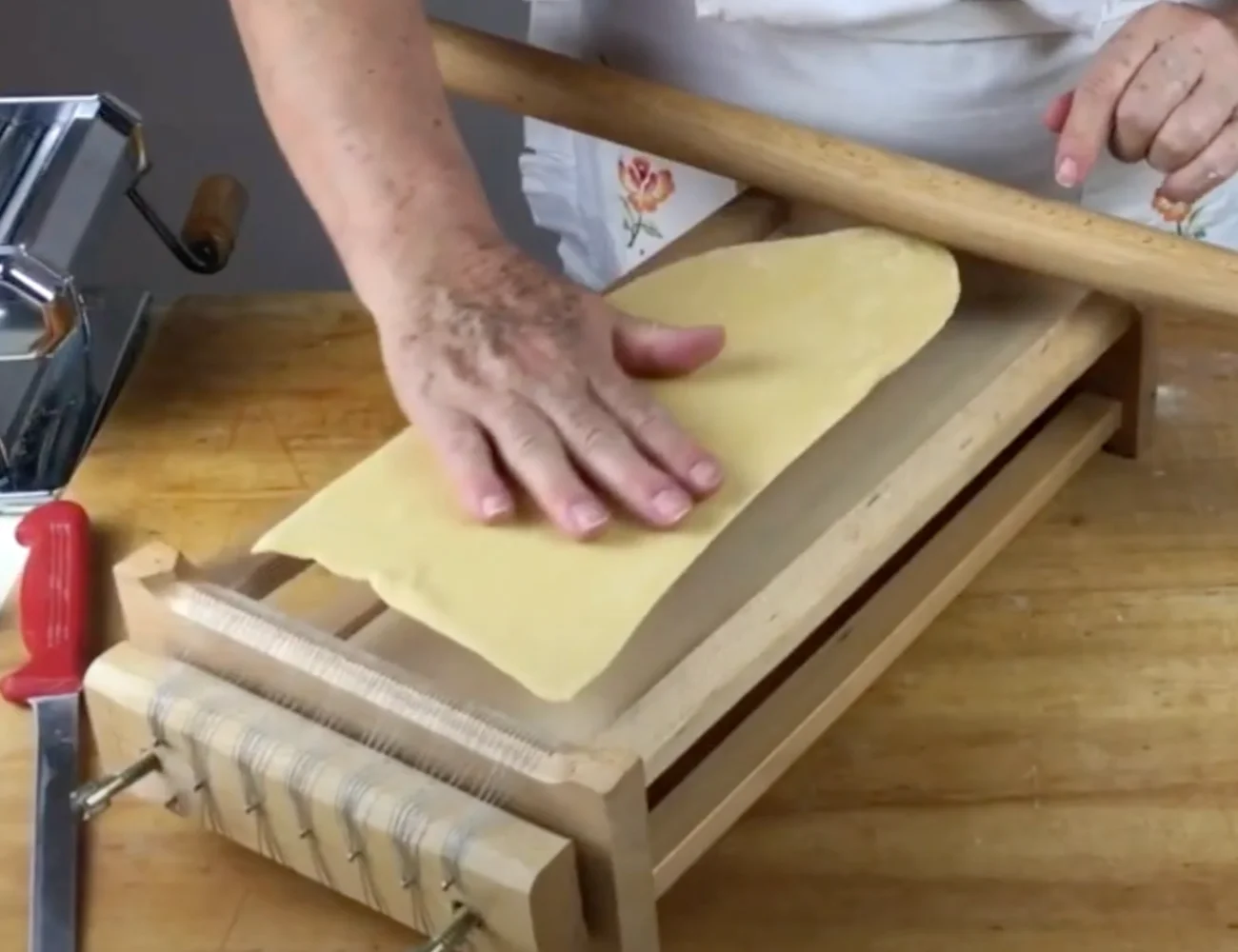
Sure, you can use a pasta cutting roller for spaghetti to cut the pasta (like the one Nonna is showing below). However, the resulting pasta with be smooth and lack the traditional texture of that cut with the chitarra.
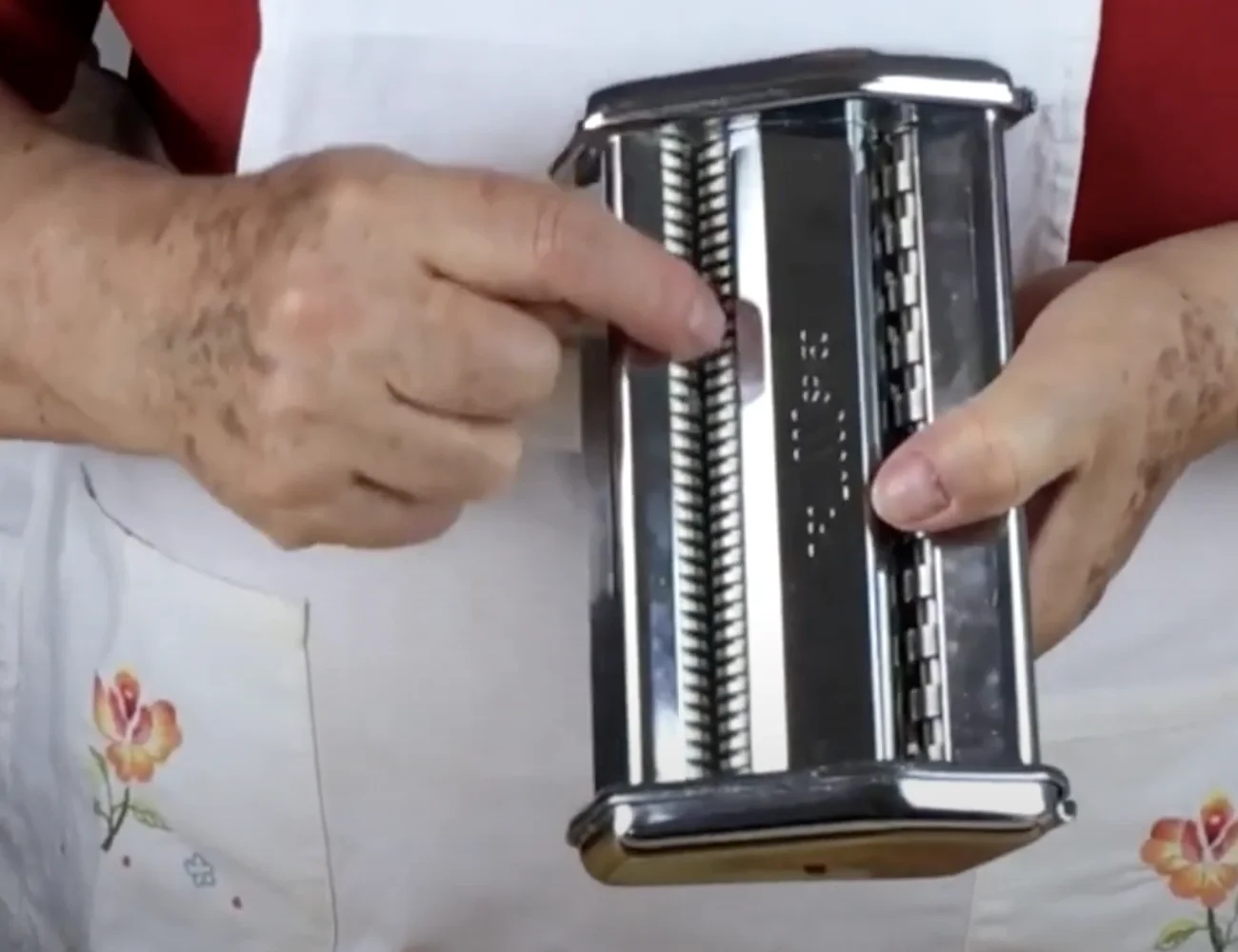
How to Choose Quality Pasta Brands? To learn more about why the best pasta brands that we recommend are bronze dye cut, check out our other article.
Ingredients for Fresh Spaghetti Pasta
Our Italian grandmas often use normal white pasta flour to make Spaghetti alla Chitarra or a mix of flours. However traditionally, fresh Spaghetti alla Chitarra is made with semola grano duro rimacinata (semolina flour) which is yellow in color. The rest of the ingredients are simply egg and a pinch of salt.
- egg
- salt
- semola grano duro (semolina flour) or a mix of semola and pasta flour
Flours We Recommend for Fresh Spaghetti (affiliate links) Gnocchi and Pasta Flour: https://amzn.to/4689LC3 Semola Flour: https://amzn.to/3F9Mdi7
In home kitchens, sometimes a drop of oil is added to the pasta dough although this is not necessary.
Traditional Sauces to Serve with Spaghetti alla Chitarra
Like many Italian pastas, Spaghetti alla Chitarra goes by different names in different regions. There are many condiments or sauces that traditionally accompanies this fantastic handmade pasta. In Lazio, this pasta is called tonnarelli and is often served with pecorino cheese sauce as variation of the Spaghetti Cacio e Pepe recipe. In Trapani? The chitarra pasta is served with Pesto alla Trapanese—a pesto made of basil, tomatoes, red garlic, almonds and pecorino.
- truffle and oil (Umbria)
- pesto alla trapanese (Trapani)
- cacio e pepe (Lazio)
- tiny meatballs (Abruzzo)
And of course, in Abruzzo, it is the traditional pasta to accompany the tiny meatballs that the region is famous for. In fact—and this may surprise you—this is the only traditional pasta that we are aware of that combines spaghetti with meatballs in Italy. The pasta dish popular in the United States— large meatballs in a sauce served with spaghetti—is not a common dish in Italy, where meatballs are usually served without sauce (alone) as an appetizer or second course.
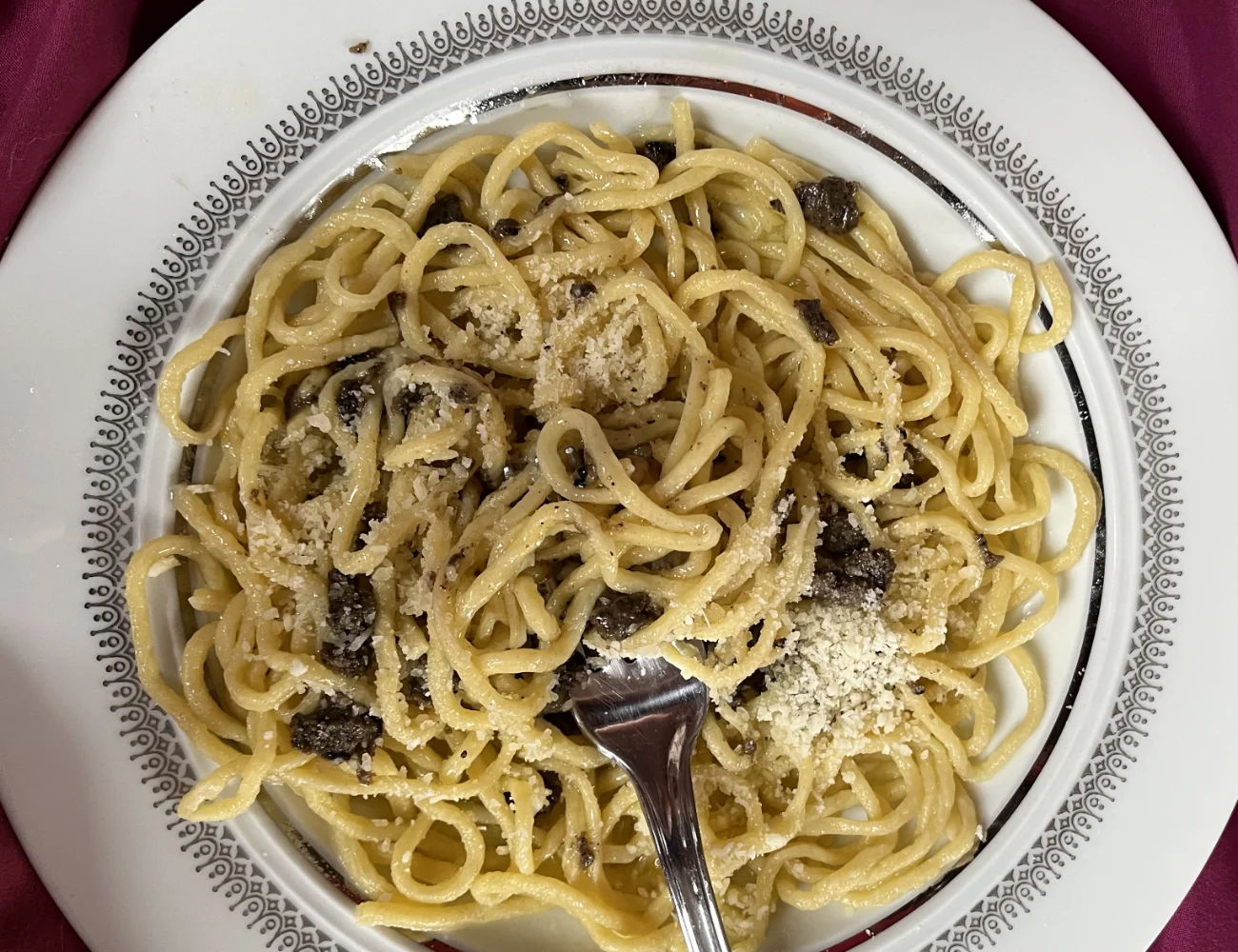
Frequently Asked Questions
“Why is Nonna Lulu’s pasta dough lighter than mine?”
In the recipe card below, we are providing a more traditional recipe for 4 people, using a mix of semolina flour and white pasta flour. This results in a more yellow dough. Nonna Lulu (like many home cooks) tends to use the flour she has on hand and in the video used white pasta flour rather than a mix.
“Should I add oil and salt to the pasta dough?”
We think this is unnecessary. Many pasta makers do add a pinch of salt or a drop of olive oil to the dough (as Nonna Lulu does in the video). Pasta is seasoned by the salt it absorbs while boiling it in salted pasta water. The pinch of salt added to the dough doesn’t do that much.
As for the olive oil, it’s better to use a drop or two of oil to correct a dough that is too dry rather than adding it from the start— in our opinion.
“Why are there only 3 eggs in the photo below?”
Nonna Lulu made pasta for 3-4. The recipe is written to serve 4 — so 4 eggs.
More Pasta Recipes on PIATTO
Check out our guide on how to make pasta with a stand mixer!
Products We Recommend
Here are some (Amazon affiliate) links to products we recommend if you want to make Spaghetti alla Chitarra at home!
Chitarra Pasta Cutter
► Chitarra Pasta Cutter (‘Made in Italy’): https://amzn.to/41KdIvh
Italian ‘Made in Italy’ Pasta Flours We Love
► Gnocchi and Pasta Flour: https://amzn.to/4689LC3
► Semola Flour: https://amzn.to/3F9Mdi7
‘Made in Italy’ Hand Crank Pasta Machines
These are the most affordable models of pasta roller/cutter machines as they are hand crank.
►Marcato: https://amzn.to/3tuia4X
► Imperia: https://amzn.to/48iEb5B
Pasta Roller and Cutter Extensions for Stand Mixers
Personally, we love these stand mixer extensions and use them regularly. They are ergonomic and the powerful stand mixer motor makes the job easy.
► Pasta Roller, KitchenAid (Set of 3): https://amzn.to/3tO8Bby
►Stand Mixer, KitchenAid (Pro): https://amzn.to/43cPHww
► Stand Mixer, KitchenAid (Artisan): https://amzn.to/3p15WhO
Pasta Work Surfaces
► Stainless Steel Work Surface / Pastry Board: https://amzn.to/3xaiFQf
As an Amazon Associate, we earn from qualifying purchases. This means at no extra cost to you, PIATTO may earn a small commission if you click the links and make a qualifying purchase.
Fresh Spaghetti alla Chitarra
Equipment
- 1 Rolling Pin or Pasta Machine for stretching the pasta
- 1 large knife or pasta cutting extension
Ingredients
- 7 oz pasta flour alternatives: all-purpose or '00'
- 7 oz semolina flour "semola grano duro rimacinata"; or look for semolina flour for pasta.
- 4 whole eggs
- 1 pinch fine salt (optional)
Instructions
Make the Pasta
- Mix the flours together in a pile on a work surface. Make a well in the center of the flour. Add the whole eggs to the center of the flour. Add the salt (optional).Begin to beat the flour into the eggs with a fork, pulling the flour in from the sides a little at a time.7 oz pasta flour, 7 oz semolina flour, 1 pinch fine salt, 4 whole eggs

- Using a stand mixer? Start with ¾ of the flour recommended and add more flour as needed. It’s better to start with too little flour than too much.
- When the dough begins to look shaggy, compress the dough into a loose ball and begin to knead. Knead the dough until it is smooth and elastic. When you push in on the dough, it should spring back.

- When the fresh pasta dough is ready, cover it and let the dough rest for at least 30 minutes. Cover it with a bowl or better yet, wrap it tightly in plastic wrap.

Stretch and Cut the Pasta
- Work with ¼ of the dough at a time. Keep those pieces you aren't working on covered or wrapped in plastic. This will prevent the pasta from drying out.
- Place ¼ of the dough on a well-floured surface. Flour both sides of the dough. Roll or press the dough into a ¼ inch (½ cm) thick rectangle.
- Pass the floured rectangle through a pasta roller, starting at the widest setting. Feed dough into machine short-side first. Then, place the dough lengthwise on the floured work surface. Fold the dough as you would a letter, starting with one side. Roll out the dough again till it is ¼ in (½ cm) thick.

- The short side of folded dough rectangle should be a little smaller than the width of your pasta roller. Then, pass the pasta through the roller again.Reduce the width of the pasta roller one setting. Pass the pasta through the roller again. Always feed the pasta in short-side firstPass the pasta through the roller, each time reducing the roller width one setting. The final thickness of the pasta dough for the spaghetti should be 2 mm. Cut the sheet of pasta into lengths of 26 cm (10").

- Time to cut the spaghetti! If using a traditional 'chitarra,' place a sheet of stretched pasta dough on top of the 'strings.' Firmly roll the rolling pin over the pasta, pushing it down and through the strings to cut the pasta. Sprinkle the cut spaghetti generously with semolina flour.

- …Or, pass the stretched dough through an appropriately-sized pasta cutter (one that cuts pasta into 2 mm). Separate the cut spaghetti into portions and sprinkle with flour to prevent sticking.

